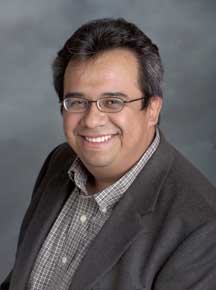CSUN Prof Confident Media Will Survive Recent Newsroom Upheavals

Newsrooms across the nation. CSUN journalism professor José Luis Benavides is confident that that the field of journalism will survive the recent spate of newsroom upheavals. Image by metamorworks, iStock.
As political polarization threatens the foundations of American democracy, newsrooms across the nation — which have long played a vital role in checking political power and keeping the citizenry informed — are laying off staff or disappearing all together.
Those that remain are struggling to retain readers/viewers while trying to figure out how to successfully transition to the digital age. California State University, Northridge journalism professor José Luis Benavides is confident that they will figure it out.
“I am a journalism professor, so I kind of have to believe,” Benavides said, with a laugh. “But at the same time, if you look at what has happened in the past, when there has been a need, journalists have found a way to fill it, to let people know what is going on.”

José Luis Benavides
Benavides admitted that journalism as we currently know it is in flux.
“I think that the size of the crisis in journalism is growing,” he said. “The industries that created journalism or have been creating journalism in the last century are in decline. ‘In decline’ is really a friendly way to say that they are going through a period in which they can’t find a way to sustain themselves as a business, which means that many of them are likely to disappear. That means a really uncertain future for those who are practicing journalism at the moment.”
Benavides, who teaches in CSUN’s Mike Curb College of Arts, Media and Communication, pointed to a study by the Pew Research Center that said in 2008 there were 115,000 people producing news across a variety of platforms. Today, that number is about 80,000, he said.
“The decrease in newspaper employment is just dramatic,” Benavides said. “Broadcast news has remained slightly steady, but the numbers do seem to be going down. The only area where employment is growing is in digital platforms.”
He pointed to digital publications like ProPublica, a nonprofit investigative journalism news site. Its reporting has drawn attention to political, health and public safety issues across the country and inspired policy changes.
“It does a wonderful job, and is a successful nonprofit,” he said. “But as a nonprofit they can’t really employ as many people as a newspaper.”
Those newspapers that are succeeding, such as The New York Times, Benavides said, are doing so by positioning themselves as “global newspapers.”
“They are able to generate enough revenue that they can continue to grow,” he said. “They are doing significant, important work, but not everybody can work at The New York Times, nor is The New York Times able to tell the stories needed to be told in communities across the country.”
In the “old days,” Benavides said, reporters would start out a small community papers covering anything and everything and work their way up to important beats or editing positions, or on to bigger, more prestigious newspapers in their community or somewhere else.
Today, he said, reporters must become “subject-matter specialists” and create a following of “readers” who respect their work and want more of it.
“They also need to be more versatile about all the forms of content creation that are not necessarily based on the written word,” Benavides said, pointing to the variety of digital platforms that are now available like podcasting.
Digital platforms, he said, are providing opportunities for communities not often covered by traditional media to get their news heard, particularly as that media continues to significantly cut their staff sizes.
He noted that the LAist, Los Angeles’ largest National Public Radio station broadcasting at 89.3 FM, is successfully filling the gaps in the coverage of the city’s numerous communities left by the downsizing of the Los Angeles Times and the variety of newspapers — from the Los Angeles Daily News and the Pasadena Star-News to the San Bernardino Sun — that make up the Southern California News Group. He pointed out that it was a reporter with Knock LA, an online nonprofit community journalism project, that broke the stories about gangs in the Los Angeles County Sheriff’s Department.
“Public media and nonprofit media are creating viable media alternatives and still providing valuable information to the community,” Benavides said. “I think ethnic newspapers, which have been heavily hit by the current crisis in journalism may find that they can thrive in a digital environment.”
“The problem is that so much of the digital media is fragmented,” he said. “You like one news site, and the algorithm sends you a link to a similar site and soon you are just seeing content that has all the same perspective. That doesn’t mean that partisan journalism is not journalism. Then, it becomes incumbent on the consumer to seek out different news sources.”
But that doesn’t mean that important topics will not make it beyond new media digital platforms, he said.
“While Knock LA may have broken the story about gangs in the sheriff’s department, the Los Angeles Timesand the other media in LA are now covering and monitoring the story,” he said. “If journalists are covering important news that impacts a community, the community will find a way to learn about it. And if there is important news that needs to be told, there will always be a journalist who will want to tell that community’s story.”

 experience
experience